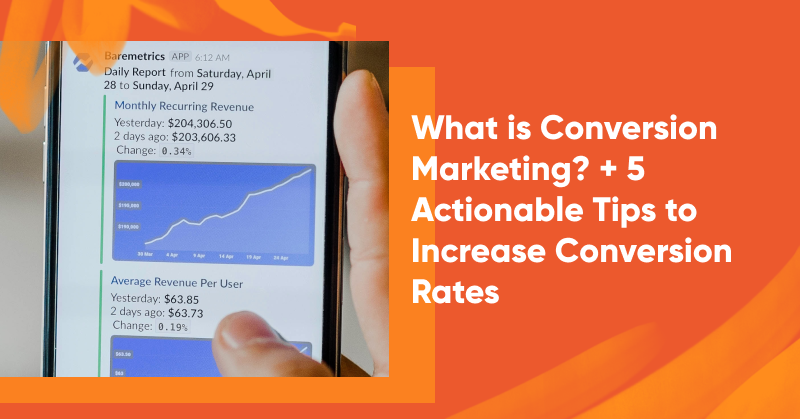If you’re an ecommerce entrepreneur looking to up your conversion marketing game, you’re in the right place.
In this article, we’re covering the basics of conversion marketing and sharing 5 conversion marketing strategies you can use to boost conversion rates in your online store.
Ready? Let’s jump right in!
What is conversion marketing?
Conversion marketing is a marketing strategy that aims to increase the proportion of your existing traffic that converts (rather than increasing your overall number of website visitors).
But what counts as a conversion? Typically in ecommerce, a conversion means a customer completing a purchase. But other actions can count as conversions too: signing up for an email marketing list, downloading a lead magnet, starting a free trial, etc.
Conversion marketing (or conversion rate optimization) is often used in tandem with other marketing efforts to build a strong conversion funnel.
Why is having a conversion marketing strategy important?
A conversion marketing strategy involves using a variety of techniques to boost your conversion rate (and, ultimately, your revenue).
That’s a pretty big incentive on its own, but it’s not the only thing you can expect from using conversion marketing tactics.
Here are just a few of the other benefits you have to look forward to:
- A better understanding of your customers: When you spend time learning about your customers as individuals, their motivations, and any conversion-blocking obstacles they face along the user journey, you’ll be much better equipped to meet their needs.
- Lower cost per acquisition: You’ll be making the most of your existing traffic without spending more on acquiring new traffic, so your CPA (cost per acquisition) will fall.
- Improvements in your search engine optimization (SEO) initiatives: When you use conversion rate optimization to make targeted improvements to your website, you’ll deliver a smoother, more enjoyable customer experience. And with search engine ranking algorithms getting more intelligent by the day, a better user experience will mean better visibility in search results (and thus, more traffic).
- Higher customer lifetime value: Once a visitor becomes a buyer, you’ll be able to show them personalized messages (like targeted product recommendations, “welcome back” messages, and restocking emails about products they’ve bought) to deepen the customer-brand relationship and encourage loyalty.
Conversion rate definition and benchmarks
Understanding conversion rate is fundamental to improving your conversion optimization efforts.
In its essence, the conversion rate measures the percentage of website visitors to your website or landing page who take a desired action (e.g. making a purchase or signing up for a newsletter).
This metric serves as a key indicator of the effectiveness of your conversion marketing strategies and the user experience you provide.
By analyzing your conversion rate, you can identify areas for improvement and implement strategies to optimize your conversion funnel and increase conversions.
For online retailers, the average conversion rate typically falls between 1% and 4%. However, this visitor conversion rate can vary based on factors such as the industry, product type, and target audience.
What tools you can use to boost your conversion rate?
Now let’s take a look at some indispensable tools you should consider incorporating if you’d like to achieve higher conversions.
1. Analytics platforms
Utilize robust analytics platforms such as Google Analytics or Adobe Analytics to gain insights into user behavior, traffic sources, and conversion funnels.
These tools provide invaluable data to identify bottlenecks in your conversion process and make informed decisions for optimization.
2. Heatmaps and session recording tools
Heatmap tools like Hotjar or Crazy Egg offer visual representations of user interactions on your website, highlighting areas of high engagement and identifying friction points.
Session recording tools allow you to watch real-time recordings of user sessions, offering qualitative insights into user behavior and pain points.
3. A/B testing software
A/B testing is a powerful technique for optimizing conversion rates by comparing variations of website elements, such as headlines, CTAs, or page layouts.
Tools like Optimizely, VWO, or OptiMonk enable you to conduct experiments and determine which variations drive more customers.
4. Popup tools
Popup tools like OptiMonk allow you to create engaging popups and overlays to capture visitor attention and encourage conversions.
Whether promoting special offers, collecting email signups, or providing exit-intent offers, popup tools can effectively boost conversion rates when used strategically.
5. Customer feedback and survey tools
Understanding the voice of your paying customers is essential for optimizing your conversion funnel.
They enable you to collect feedback through surveys, polls, and on-site feedback widgets, helping you uncover insights and address customer concerns.
5 easy-to-implement conversion rate optimization strategies
Successful conversion rate optimization begins with gathering and analyzing your conversion metrics. Once you have a good understanding of where along your conversion funnel you’re losing the most customers, you can start building your strategy.
These tried-and-tested conversion tactics are a great place to start. Get ready to take notes!
1. Optimize your website for mobile
84% of customers have had trouble completing a mobile transaction. And 40% of people with a negative mobile experience will switch to a competitor. With stats like those, it’s easy to see why it’s so critical to ensure your website is optimized for mobile!
Here are some quick tips to improve the mobile friendliness of your site:
- Use a tool like Google’s Mobile-Friendly Test or PageInsights to learn how mobile friendly your website is.
- Ensure your website is responsive (designed to look great on all screen sizes).
- Check your website’s Core Web Vitals.
- Improve your site’s load time.
- Avoid large blocks of text. Keep your copy concise!
- Make sure your popups are mobile friendly.
2. Provide personalized content and offers
Personalization boosts consumer engagement, which leads to higher conversion rates according to 63% of marketing strategists. Online buyers prefer individualized shopping experiences, and they’ve actually come to expect them across the web.
In short, if you’re not offering personalized information and offers, you’re missing out!
The extent to which an online retailer personalizes the customer experience has a big impact on shoppers’ buying decisions. One excellent strategy to improve conversions is to provide personalized product recommendations.
For example, Dollar Shave Club recommends products based on each customer’s skin type. Customers can then customize their orders to include the products they want.
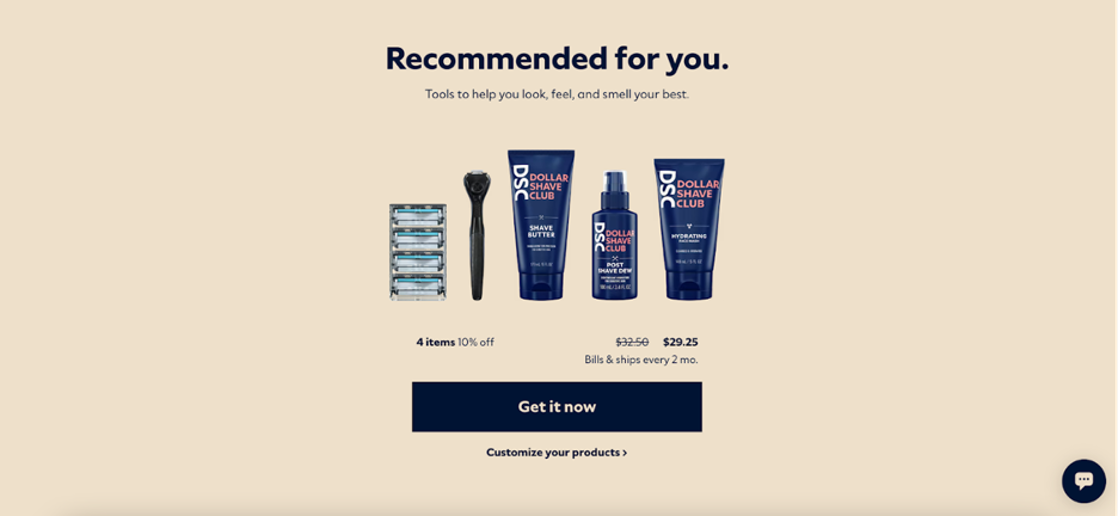
Another great example comes from Urban Outfitters: they push their top products but create the impression that each customer is being helped personally by the brand itself, all with a simple headline: “Just for You.”
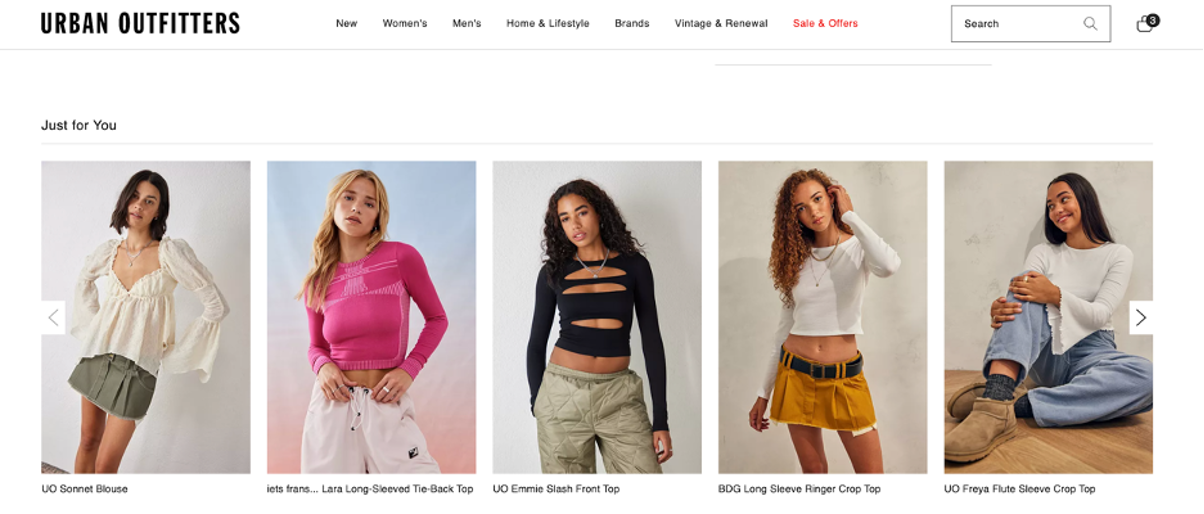
You can create powerful personalized campaigns, including product recommendation campaigns like the ones above, using OptiMonk.
3. Use exit-intent popups
Exit-intent popups offer you one final chance to engage with website visitors who are leaving your site, which can help you save conversions.
How do they work?
Basically, when a user’s activity indicates that they’re about to exit your site, the popup appears milliseconds before they do with a compelling offer or product recommendation to keep them browsing.
They’re ideal for boosting your conversions without interfering with your visitors’ overall experience, and they can also be used for lead generation. After all, if a visitor isn’t going to make a purchase, gaining an email address is the next best thing! This way, you can nurture the relationship and move them towards a purchase in the future.
Exit-intent popups like the one below by KissMyKeto prompt website visitors to take immediate action. The countdown timer combined with the 15% off coupon makes this offer irresistible for new customers.
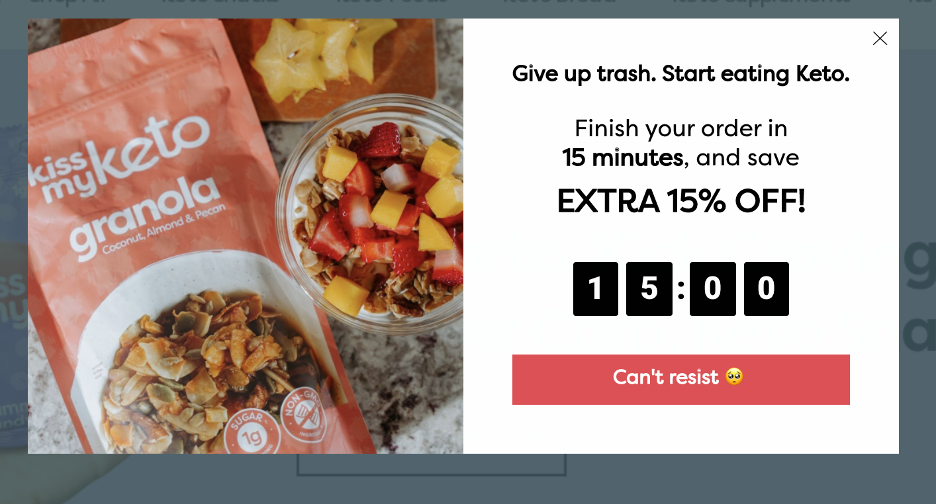
Create similar exit-intent popups with these templates:
4. Build trust
Today, consumers tend to be very skeptical of brands, especially DTC brands. And can you blame them? The internet is full of marketing fraud, bogus reviews, and fake influencers.
But all is not lost for ecommerce entrepreneurs: you’ll just need to put in some extra effort to win and keep your customers’ trust!
You can build trust (and by extension, get more conversions) by doing things like:
- Displaying genuine reviews and endorsements
- Delivering top-notch customer service
- Showing awards and trust badges
- Offering useful, relevant content
- Giving your company a face
- Making your shipping and return policies easy to find
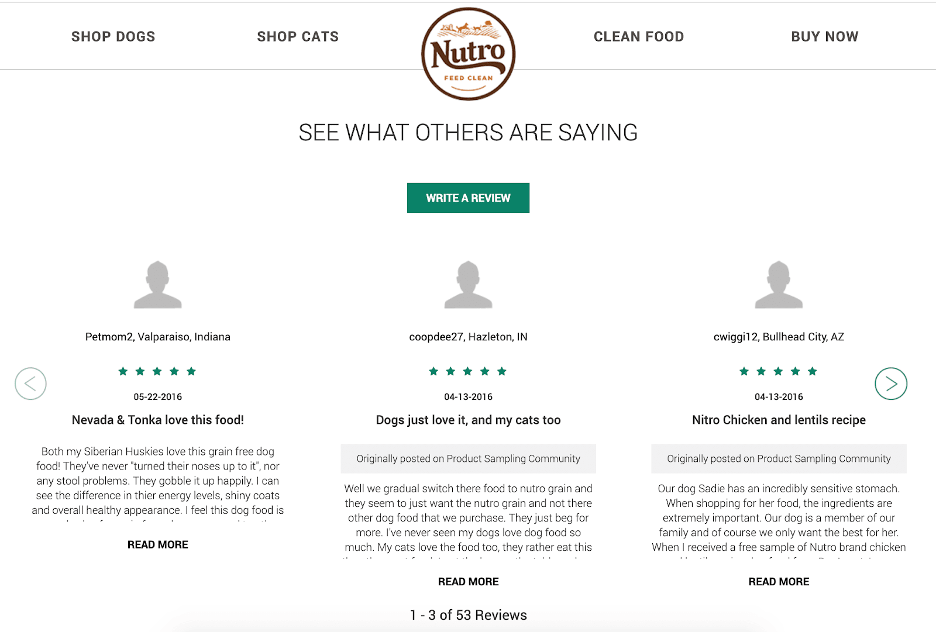
5. Create a sense of urgency
There are several different ways to evoke a sense of urgency, which encourages visitors to buy now rather than later.
Making products or offers available only for a limited amount of time is a very effective way off creating urgency.
Scarcity is closely related to urgency. By creating scarcity, you’ll show your shoppers that you only have a limited supply of a product so they’ll be more willing to take action.
Some of the most powerful offers combine urgency and scarcity, as Groupon does below. Notice the callouts for “limited time only” and “limited quantity available.”
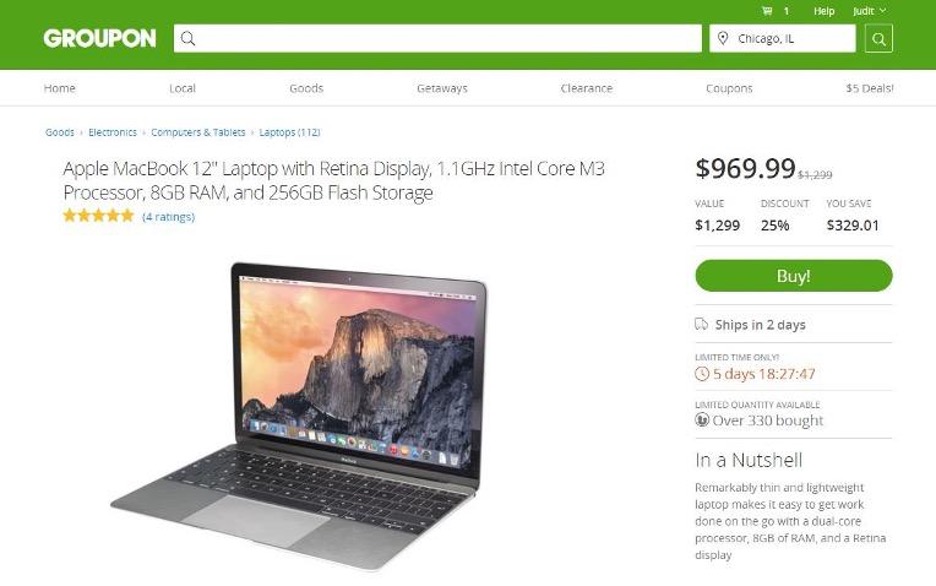
Another way of creating urgency involves displaying real-time counters of things like:
- How many visitors are currently looking at the item
- How many visitors have viewed the item in the past week
- How many visitors have the item in their cart
- How many visitors have bought the item
- …and so on.
The fear of missing out (FOMO) is a powerful motivator, so you should definitely consider using urgency to boost your conversions.
Interested in more conversion optimization tips? Watch this video for strategies that can elevate your revenue and conversions:
FAQ
What is an example of a conversion in marketing?
In marketing, conversion refers to any desired action taken by a visitor or customer that aligns with your business goals. Common examples include making a purchase on an ecommerce website or signing up for a newsletter or email subscription.
What is the meaning of conversion in marketing campaigns?
The meaning of conversion can vary depending on the objectives of the campaign, which may include generating sales and revenue, acquiring new leads or prospects, increasing website traffic or engagement, or building brand awareness or loyalty. Ultimately, the meaning of conversion in marketing campaigns is tied to the specific goals and objectives that marketers set out to accomplish, and it serves as a key metric for measuring the effectiveness and ROI of their efforts.
Summary
That wraps up our list of 5 conversion marketing tactics you can use in your own ecommerce business. Hopefully they’ve inspired you to start working on optimizing your conversion rates!
The most powerful strategies for improving your conversion rate all rely on personalization. If you’d like to learn more about website personalization and create highly relevant messages that feel like a one-on-one interaction between your brand and your potential customers, check out this guide.
Do you have a favorite conversion marketing tactic that didn’t make the list? Tell us about it in the comments!
